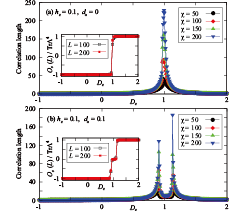Trivial Yet Distinct
Y. Fuji, F. Pollmann, and M. Oshikawa
Classification of quantum phases is a central subject in statistical mechanics and condensed matter physics. Traditionally, it was based on the notion of spontaneous symmetry breaking, as initiated by Landau. However, recently, a rich variety of quantum phases without any spontaneous symmetry breaking has been recognized. This also requires us to develop new concepts and formulations. One of the novel classes of quantum phases is called Symmetry-Protected Topological (SPT) phases. As the name suggests, they are distinct from the trivial phase only in the presence of an appropriate symmetry. In this regard, SPT phases are similar to the conventional ordered phases with a spontaneously broken symmetry. However, SPT phases do not break the symmetry, and hence are called topological. A well-known example of SPT phases is the topological insulator, which possesses a helical edge state and is distinct from a trivial band insulator. The helical edge state and the distinction from a trivial band insulator however go away once the time-reversal symmetry is broken explicitly. Another example of SPT phases is Haldane phase in S =1 antiferromagnetic chains. There is no long-range order which can be detected by a local order parameter in the Haldane phase. Nevertheless, the Haldane phase is separated by a quantum phase transition from a trivial phase such as “large-D phase” which includes the product of Sz =0 states. The Haldane phase also has a characteristics of edge state (free spin), which is protected by the time-reversal symmetry. It turns out however that the edge states are not the most general characterization of SPT phases. Under the lattice inversion symmetry, there are topological insulator and Haldane phase without any physical edge state. These are most generally characterized by degeneracy in the entanglement spectrum. This implies that they are distinct, in the presence of the symmetry, from a trivial product state without any entanglement.

Fig. 1. Divergence of the correlation length demonstrating the existence of the quantum phase transition separating the two trivial phases. Insets show the non-local string order parameter which distinguishes the two phases.
In a recent joint research [1] we demonstrated that the notion of symmetry protection of quantum phases can be generalized in a somewhat surprising manner. In the standard SPT phases, as we discussed above, there is a nontrivial entanglement which makes the state distinct from a trivial product state. We showed that, in the presence of a certain class of inversion symmetry, there are two trivial phases that are still distinct, in a simple model of S =1 chain. By “trivial phase” we mean the ground state can be adiabatically connected to a product state where there is no entanglement at all. Nevertheless the two trivial phases are distinct in the sense that they are always separated by a quantum phase transition as long as the symmetry is kept. We dubbed them “Symmetry-Protected Trivial (SPt)” phases. We have also formulated a non-local string order parameter which can distinguish these phases and detect the quantum phase transition between them. So, there is something nontrivial even in trivial phases! This would also add a new aspect to the fundamental question “What is phase?”.
This work was performed in collaboration between ISSP and Max-Planck Institute for Physics of Complex Systems, which is recently strengthened by the JSPS Strategic International Networks Program No. R2604 “TopoNet.”
References
- [1] Y. Fuji, F. Pollmann, and M. Oshikawa, Phys. Rev. Lett. 114, 177204 (2015).
